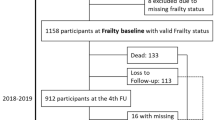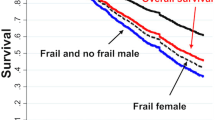Abstract
Objectives
To examine sex differences in prevalent comorbidity and frailty across age and European regions.
Methods
This is a cross-sectional study based on 113,299 Europeans aged 50+ participating in the Survey of Health, Ageing and Retirement in Europe from 2004–2005 to 2015. Sex differences in the Comorbidity Index and the Frailty Phenotype were investigated using ordinal logistic regressions.
Results
European women had generally higher odds of prevalent comorbidity (OR 1.11, 95% CI 1.07–1.15) and frailty (OR 1.56, 95% CI 1.51–1.62). Sex differences increased with advancing age. No overall sex difference in comorbidity was found in Western Europe, but women had more comorbidity than men in Eastern (OR 1.30, 95% CI 1.18–1.44), Southern (OR 1.23, 95% CI 1.15–1.30), and Northern (OR 1.08, 95% CI 1.01–1.16) Europe. Women were frailer than men in all regions, with the largest sex difference in Southern Europe (OR 1.84, 95% CI 1.72–1.96).
Conclusions
European women are frailer and have slightly more comorbidity than European men lending support for the male–female health survival paradox.

Similar content being viewed by others
References
Ahrenfeldt LJ, Lindahl-Jacobsen R, Rizzi S, Thinggaard M, Christensen K, Vaupel JW (2018a) Comparison of cognitive and physical functioning of Europeans in 2004–05 and 2013. Int J Epidemiol. https://doi.org/10.1093/ije/dyy094
Ahrenfeldt LJ, Scheel-Hincke LL, Kjaergaard S, Moller S, Christensen K, Lindahl-Jacobsen R (2018b) Gender differences in cognitive function and grip strength: a cross-national comparison of four European regions. Eur J Public Health. https://doi.org/10.1093/eurpub/cky266
Andersen-Ranberg K, Petersen I, Frederiksen H, Mackenbach JP, Christensen K (2009) Cross-national differences in grip strength among 50+ year-old Europeans: results from the SHARE study. Eur J Ageing 6:227–236. https://doi.org/10.1007/s10433-009-0128-6
Austad SN, Fischer KE (2016) Sex differences in lifespan. Cell Metab 23:1022–1033. https://doi.org/10.1016/j.cmet.2016.05.019
Barford A, Dorling D, Davey SG, Shaw M (2006) Life expectancy: women now on top everywhere. BMJ 332:808
Beckett M, Weinstein M, Goldman N, Yu-Hsuan L (2000) Do health interview surveys yield reliable data on chronic illness among older respondents? Am J Epidemiol 151:315–323
Bergmann M, Kneip T, Luca D, Giuseppe, Scherpenzeel, Annette (2017) Survey participation in the Survey of Health, Ageing and Retirement (SHARE), wave 1–6. Based on Release 6.0.0 (March 2017)
Börsch-Supan A, Jürges H (2005) The survey of health, aging, and retirement in Europe—methodology. MEA, Mannheim
Börsch-Supan A, Brandt M, Hunkler C et al (2013) Data resource profile: the Survey of Health, Ageing and Retirement in Europe (SHARE). Int J Epidemiol 42:992–1001. https://doi.org/10.1093/ije/dyt088
Bouillon K, Kivimaki M, Hamer M et al (2013) Measures of frailty in population-based studies: an overview. BMC Geriatr 13:64. https://doi.org/10.1186/1471-2318-13-64
Case A, Paxson C (2005) Sex differences in morbidity and mortality. Demography 42:189–214
Chen X, Mao G, Leng SX (2014) Frailty syndrome: an overview. Clin Interv Aging 9:433–441. https://doi.org/10.2147/cia.s45300
Christensen K, Thinggaard M, Oksuzyan A et al (2013) Physical and cognitive functioning of people older than 90 years: a comparison of two Danish cohorts born 10 years apart. Lancet 382:1507–1513. https://doi.org/10.1016/s0140-6736(13)60777-1
Cimas M, Ayala A, Sanz B, Agullo-Tomas MS, Escobar A, Forjaz MJ (2018) Chronic musculoskeletal pain in European older adults: cross-national and gender differences. Eur J Pain 22:333–345. https://doi.org/10.1002/ejp.1123
Clegg A, Young J, Iliffe S, Rikkert MO, Rockwood K (2013) Frailty in elderly people. Lancet 381:752–762. https://doi.org/10.1016/s0140-6736(12)62167-9
Collard RM, Boter H, Schoevers RA, Oude Voshaar RC (2012) Prevalence of frailty in community-dwelling older persons: a systematic review. J Am Geriatr Soc 60:1487–1492. https://doi.org/10.1111/j.1532-5415.2012.04054.x
Cook MB, Dawsey SM, Freedman ND et al (2009) Sex disparities in cancer incidence by period and age. Cancer Epidemiol Biomark Prev 18:1174–1182. https://doi.org/10.1158/1055-9965.epi-08-1118
Crimmins EM, Kim JK, Sole-Auro A (2011) Gender differences in health: results from SHARE, ELSA and HRS. Eur J Public Health 21:81–91. https://doi.org/10.1093/eurpub/ckq022
Dahlin J, Harkonen J (2013) Cross-national differences in the gender gap in subjective health in Europe: does country-level gender equality matter? Soc Sci Med 98:24–28. https://doi.org/10.1016/j.socscimed.2013.08.028
Dix D (2014) The female health-survival advantage: paradox unwarranted. Int J Public Health 59:213. https://doi.org/10.1007/s00038-013-0505-y
Eurostat (2019) Life expectancy by age and sex. Eurostat. https://appsso.eurostat.ec.europa.eu/nui/show.do?dataset=demo_mlexpec&lang=en. Accessed 27 Feb 2019
Fried LP, Tangen CM, Walston J et al (2001) Frailty in older adults: evidence for a phenotype. J Gerontol A Biol Sci Med Sci 56:M146–M156
Gold CH, Malmberg B, McClearn GE, Pedersen NL, Berg S (2002) Gender and health: a study of older unlike-sex twins. J Gerontol B Psychol Sci Soc Sci 57:S168–S176
Gordon EH, Peel NM, Samanta M, Theou O, Howlett SE, Hubbard RE (2017) Sex differences in frailty: a systematic review and meta-analysis. Exp Gerontol 89:30–40. https://doi.org/10.1016/j.exger.2016.12.021
Hazra NC, Dregan A, Jackson S, Gulliford MC (2015) Differences in health at age 100 according to sex: population-based cohort study of centenarians using electronic health records. J Am Geriatr Soc 63:1331–1337. https://doi.org/10.1111/jgs.13484
Hubbard RE, Rockwood K (2011) Frailty in older women. Maturitas 69:203–207. https://doi.org/10.1016/j.maturitas.2011.04.006
Jones DM, Song X, Rockwood K (2004) Operationalizing a frailty index from a standardized comprehensive geriatric assessment. J Am Geriatr Soc 52:1929–1933. https://doi.org/10.1111/j.1532-5415.2004.52521.x
Kingston A, Davies K, Collerton J et al (2014) The contribution of diseases to the male-female disability-survival paradox in the very old: results from the Newcastle 85+ study. PLoS ONE 9:e88016. https://doi.org/10.1371/journal.pone.0088016
Nybo H, Gaist D, Jeune B, McGue M, Vaupel JW, Christensen K (2001) Functional status and self-rated health in 2,262 nonagenarians: the Danish 1905 Cohort Survey. J Am Geriatr Soc 49:601–609
Oksuzyan A, Juel K, Vaupel JW, Christensen K (2008) Men: good health and high mortality. Sex differences in health and aging. Aging Clin Exp Res 20:91–102
Oksuzyan A, Petersen I, Stovring H, Bingley P, Vaupel JW, Christensen K (2009) The male-female health-survival paradox: a survey and register study of the impact of sex-specific selection and information bias. Ann Epidemiol 19:504–511. https://doi.org/10.1016/j.annepidem.2009.03.014
Oksuzyan A, Crimmins E, Saito Y, O’Rand A, Vaupel JW, Christensen K (2010) Cross-national comparison of sex differences in health and mortality in Denmark, Japan and the US. Eur J Epidemiol 25:471–480. https://doi.org/10.1007/s10654-010-9460-6
Oksuzyan A, Shkolnikova M, Vaupel JW, Christensen K, Shkolnikov VM (2014) Sex differences in health and mortality in Moscow and Denmark. Eur J Epidemiol 29:243–252. https://doi.org/10.1007/s10654-014-9893-4
Okura Y, Urban LH, Mahoney DW, Jacobsen SJ, Rodeheffer RJ (2004) Agreement between self-report questionnaires and medical record data was substantial for diabetes, hypertension, myocardial infarction and stroke but not for heart failure. J Clin Epidemiol 57:1096–1103. https://doi.org/10.1016/j.jclinepi.2004.04.005
Radkiewicz C, Johansson ALV, Dickman PW, Lambe M, Edgren G (2017) Sex differences in cancer risk and survival: a Swedish cohort study. Eur J Cancer 84:130–140. https://doi.org/10.1016/j.ejca.2017.07.013
Rich-Edwards JW, Manson JE, Hennekens CH, Buring JE (1995) The primary prevention of coronary heart disease in women. N Engl J Med 332:1758–1766. https://doi.org/10.1056/nejm199506293322607
Romero-Ortuno R, Walsh CD, Lawlor BA, Kenny RA (2010) A frailty instrument for primary care: findings from the Survey of Health, Ageing and Retirement in Europe (SHARE). BMC Geriatr 10:57. https://doi.org/10.1186/1471-2318-10-57
Santos-Eggimann B, Cuenoud P, Spagnoli J, Junod J (2009) Prevalence of frailty in middle-aged and older community-dwelling Europeans living in 10 countries. J Gerontol A Biol Sci Med Sci 64:675–681. https://doi.org/10.1093/gerona/glp012
Saum KU, Dieffenbach AK, Muller H, Holleczek B, Hauer K, Brenner H (2014) Frailty prevalence and 10-year survival in community-dwelling older adults: results from the ESTHER cohort study. Eur J Epidemiol 29:171–179. https://doi.org/10.1007/s10654-014-9891-6
Theou O, Rockwood MR, Mitnitski A, Rockwood K (2012) Disability and co-morbidity in relation to frailty: how much do they overlap? Arch Gerontol Geriatr 55:e1–e8. https://doi.org/10.1016/j.archger.2012.03.001
United Nations Educational, Scientific and Cultural Organisation (UNESCO) (1997) International standard classification of education (ISCED). UNESCO, Paris
Van de Velde S, Bracke P, Levecque K (2010) Gender differences in depression in 23 European countries. Cross-national variation in the gender gap in depression. Soc Sci Med 71:305–313. https://doi.org/10.1016/j.socscimed.2010.03.035
Van Oyen H, Nusselder W, Jagger C, Kolip P, Cambois E, Robine JM (2013) Gender differences in healthy life years within the EU: an exploration of the “health-survival” paradox. Int J Public Health 58:143–155. https://doi.org/10.1007/s00038-012-0361-1
Vasilopoulos T, Kotwal A, Huisingh-Scheetz MJ, Waite LJ, McClintock MK, Dale W (2014) Comorbidity and chronic conditions in the National Social Life, Health and Aging Project (NSHAP), Wave 2. J Gerontol B Psychol Sci Soc Sci 69(Suppl 2):S154–S165. https://doi.org/10.1093/geronb/gbu025
Weber D, Skirbekk V, Freund I, Herlitz A (2014) The changing face of cognitive gender differences in Europe. Proc Natl Acad Sci USA 111:11673–11678. https://doi.org/10.1073/pnas.1319538111
Whitacre CC (2001) Sex differences in autoimmune disease. Nat Immunol 2:777–780. https://doi.org/10.1038/ni0901-777
World Health Organization (2013) Review of social determinants and the health divide in the WHO European Region: final report. Denmark, Copenhagen
Acknowledgements
This paper uses data from SHARE Waves 1, 2, 4, 5 and 6, see Börsch-Supan et al. (2013) for methodological details (Börsch-Supan et al. 2013). The SHARE data collection has been primarily funded by the European Commission through FP5 (QLK6-CT-2001-00360), FP6 (SHARE-I3: RII-CT-2006-062193, COMPARE: CIT5-CT-2005-028857, SHARELIFE: CIT4-CT-2006-028812) and FP7 (SHARE-PREP: No. 211909, SHARE-LEAP: No. 227822, SHARE M4: No. 261982). Additional funding from the German Ministry of Education and Research, the Max Planck Society for the Advancement of Science, the U.S. National Institute on Aging (U01_AG09740-13S2, P01_AG005842, P01_AG08291, P30_AG12815, R21_AG025169, Y1-AG-4553-01, IAG_BSR06-11, OGHA_04-064, HHSN271201300071C) and from various national funding sources is gratefully acknowledged (see www.share-project.org).
Author information
Authors and Affiliations
Corresponding author
Ethics declarations
Conflict of interest
The authors declare that they have no conflict of interests.
Ethical approval
This study was part of the Survey of Health, Ageing and Retirement in Europe (SHARE), a cross-national panel database of microdata on health, socioeconomic status and social and family networks of more than 120,000 individuals aged 50 or older covering 27 European countries and Israel. The SHARE study is under continuous ethics review. Waves 1–4 were approved by the Ethics Committee of the University of Mannheim. Wave 4 and onwards were approved by the Ethics Council of the Max Planck Society for the Advancement of Science (MPG). Further information on SHARE is presented in Börsch-Supan et al. (2013) and Börsch-Supan and Jürges (2005) and on the SHARE webpage (www.share-project.org).
Informed consent
Written informed consent was obtained from all participants included in the study.
Additional information
Publisher's Note
Springer Nature remains neutral with regard to jurisdictional claims in published maps and institutional affiliations.
Major Revision: 22 February 2019.
Minor Revision: 29 May 2019.
Electronic supplementary material
Below is the link to the electronic supplementary material.
Rights and permissions
About this article
Cite this article
Ahrenfeldt, L.J., Möller, S., Thinggaard, M. et al. Sex Differences in Comorbidity and Frailty in Europe. Int J Public Health 64, 1025–1036 (2019). https://doi.org/10.1007/s00038-019-01270-9
Received:
Accepted:
Published:
Issue Date:
DOI: https://doi.org/10.1007/s00038-019-01270-9




